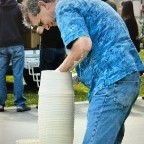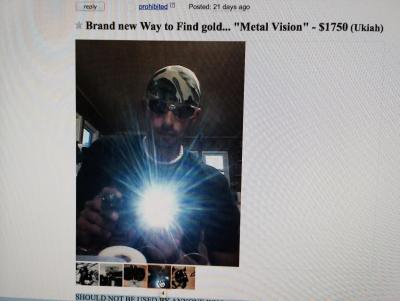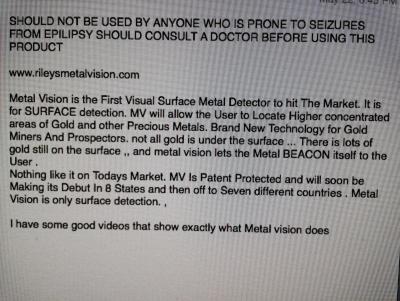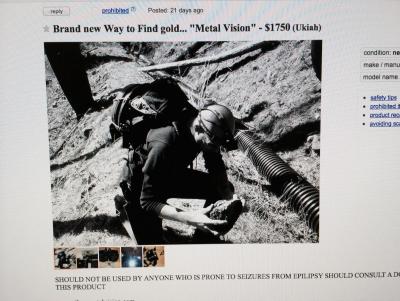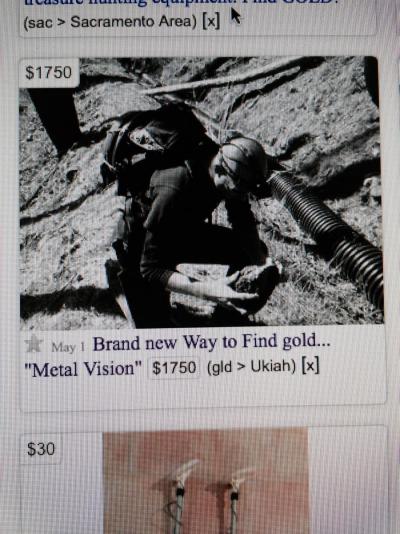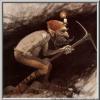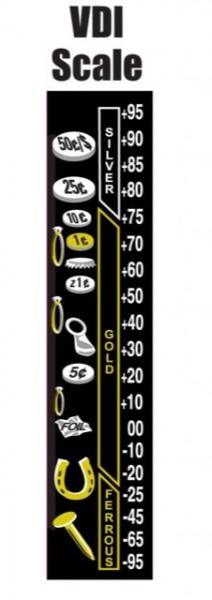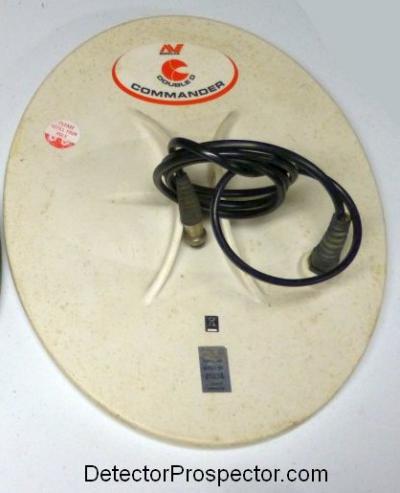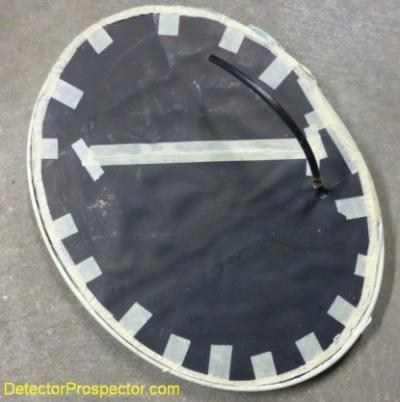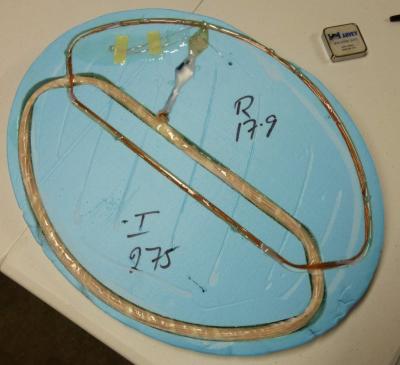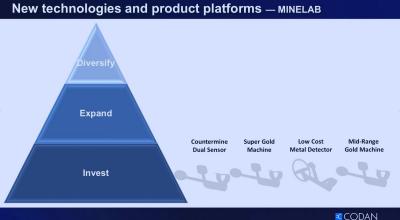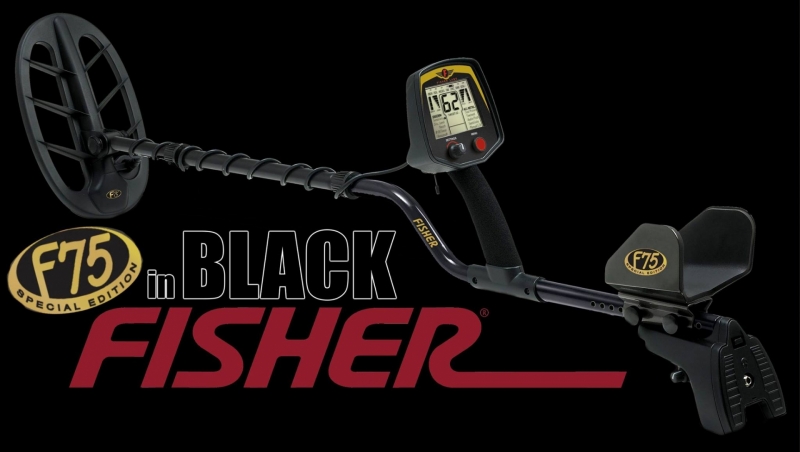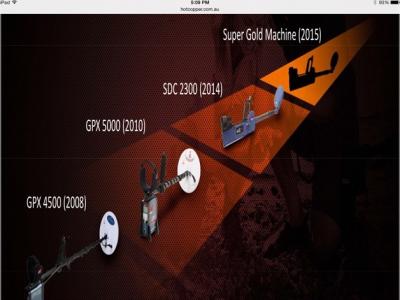Search the Community
Showing results for tags 'detector tech'.
-
Every piece of gold I have run across my machine I get a reading between 42 and 48.... Someone showed me a 1oz. nugget and when I ran my machine over it the target i.d was 82 so I was guessing that it wasn't a good quality if any gold at all...the person said because of its size the reading was higher....WEEEELLLLLLL when I got home I ran a 1/2 oz and a DWT piece over the coil and each pulled a reading of 44 and 47... I ask if this is correct because while hunting I have run across targets of 80 and up and from my experience with my machine that is usually bird shot or some other metal other than gold and I ignore some targets because of this...AM I PASSING UP GOLD NUGGETS???
-
While looking around on the Minelab site I came across this article by Bruce Candy. It will certainly be a re-read for some but for me it was a first. There is much more than just Minelab in the article. It included ground balancing, discrimination, gold detectors, coin detectors and a host of other related issues with knowing some of the technology about target detecting. It doesn't yet include ZED technology but does explain why it is so hard to have a gold detector that discriminates. (When you discriminate you lose targets!) Metal Detector Basics & Theory by Bruce Candy
-
What we don't have is the perfect gold detector and chances are we probably never will. If we did have it however what would it be like and what would it do? Here's my list. Weight - doesn't need to be a featherweight – perhaps around 3 pounds maximum. Power – lithium ion battery pack rechargeable in place or out of the detector – with spare batteries costing less than $100. But what does it have to do? Depth – of course more is better – but performing as well as the ATX overall would probably be enough. Sensitivity to small gold – as good as the minelab SDC. Ground tracking – combination of AutoTrak and ground grab - with no ground balance system induced "holes" where certain targets can't be detected because of the ground balance setting. Mineralization – should ignore it as well as a GPX 5000. Hot rocks – same as above. Discrimination – positive identification of ferrous material to depth. Price – now I am really dreaming – $1500 for the non-waterproof lightweight field model and $2500 for the waterproof ruggedized one. So can this miracle machine ever actually be developed? It would take some new and different technology since induction balance VLF machines can't do it and conventional pulse induction machines can't do it (the GB "holes") and the GPZ can do a lot of it but it costs an absolutely silly amount of money and weighs a ton. There would be no particular reason to hope that this will never be developed except for one thing – $$$ - currently in Africa they are buying thousands of gold detectors a MONTH. My imaginary miracle machine could make its developers an enormous pile of money. I will bet the price of a decent dinner at the best Mexican restaurant in Globe, Arizona that several companies are feverishly striving to develop just such a device. I know we all wish them luck.
-
I am different! I want to know why and what makes it work, what makes it different. I want to know the technical differences between products. The manufacturer can give a detector a name and claim that his detector is the best for detecting for gold. Sorry, manufacturer's claims come in one ear and out the other. Give me the facts and let me decide. I am going through the process of de-coding manufacturer claims and guess what. It is real hard to just find the facts. Right now I am searching for a list of the operating kHz frequencies of all metal detectors. Let's face it, a coil just creates a magnetic field and the only variables on any coil is the kHz frequency and the size of the coil. At least those are the two variables that I have found so far. I really need to know whether the kHz frequency is determined by the operating frequency for the Detector control box or is it controlled by the operating frequency of the coil? It makes sense to me that when you wind the copper wire into a coil that you should be able to determine the coil's kHz frequency by the number of winds of the copper wire, when you are making the coil. So, I am thinking that the coil actually determines the frequency that is built into the control box of the metal detector. Am I right? What I need now, is for someone who knows more about the industry to step up to the plate and provide a list of the kHz frequencies of the metal detector coils that are currently on the market. Any two coils that has the same kHz frequencies, whether it is made by the same manufacturer or not, should be interchangeable. A magnetic field is just a magnetic field. The operating kHz frequency, does it affect the magnetic field? If so, I need another expert to tell me whether different frequencies get better results, depending upon what the prospector is searching for. Please, do not respond to these questions unless you have scientific facts to back up what you say. If anyone can set me straight and help me get the facts I'm looking for, I would appreciate your time and effort. Don't worry, any response you give will not offend me. Thanks, Professor Hester
-
Metal detecting and more particularly Gold nuggett hunting – it's different than other hobbies. You don't ask some guy riding around on the Harley or driving a quad or a bass boat how soon he plans to break even on his investment. They look at you like you were nuts – what a silly question – this isn't about money it's about having fun! Ou hobby is different. Treasure hunting is about treasure and discovering treasure is about the thrill but it's also about the money. A $10,000 metal detector is criticized on the grounds of how many ounces of gold you would have to find to pay for it. The satisfaction of owning the pinnacle of gold detecting technology – or the pure pleasure of hunting for and finding an elusive target – seem to mean less to us than they do to the golf club, quad offroader, bass boat crowd. I'm not saying it's a good thing or a bad thing – but it is a noticeable thing. I believe to some degree it's also a reaction against the fact that metal detector prices have long been based on the hope that the buyer has of financial gain and therefore - his willingness to pay a premium for a rather straightforward electronic gadget. It is the kind of tax on hope.
-
I heard this rumor once white had chance at buying out minelab, any truth to this? It was years ago.
-
With modern ARM or similar type MCU's with some of the DSP capabilities built in and programming easily altered or updated I'm not sure I understand anymore why we are still stuck with the solid state mindset that x detector has to be y frequency only. A guy shouldn't have an issue switching to 60khz or 30khz or 7.5khz or whatever he wants without having to buy proprietary peripherals like special coils. This doesn't have a lot to do with the Makros in particular, but this line of thought leads me to really wonder when we see the first "open source" detector. IE, one that allows us to go in and hack around in the programming, and open source schematics so we can make custom mods without figuring out how to dissolve 5 layers of epoxy potting without killing the components or having to brute force decrypt MCU coding. So, since I know the Makro guys read this forum, if a company really wanted to take the next step and to be revolutionary in the detector world - provide us all with 2 open source platforms (meaning both software and hardware open source) - a PI and a VLF. Breakout all the relevant MCU pins too or allow easy access to hook up another dev board like the BeagleBoard, Raspberry PI, etc along with the interface to a computer for programming. Detectors, even Minelab, until the last few years have really been stuck in the stone age it seems to me any computer or phone nowadays allows for all kinds of mods and hacking. I think you'd see a lot of real interesting innovation happening by DIY'ers within a few years with a platform like this, and it might give Minelab some pause at offering detectors at (disclaimer, just a guess) $8,000 or whatever. Sorry to ramble, this post just got me thinking.
-
I did not want to get off topic on another post so I figured I better start a new one to find out the answer to a reply Klunker made " My thanks to Nokta for communicating with the folks that actually use detectors. Gold brick;- I have a P.I. detector that has nearly 100% accurate discrimination." O.K. klunker, I'll bite . Although I know it is probably a mistake and I am gonna get Klunkered for some reason I can not help but ask the question " Pray tell, what PI would that be, Klunker?" I think I am gonna regret getting up this morning............
-
Hi guys! I asked for advice on choosing a forum detector (http://www.detectorprospector.com/forum/topic/91-choose-detector/#entry632) . I was planning to buy an inexpensive VLF detector. But I got a bonus at work and bought a used GPX 5000. I went with this detector on some old gold deposits. I found 6 nuggets total weight of 6 grams. GPX 5000 detector is good, but I dug a lot of iron objects. I lost a lot of time digging for iron things. Gold mines are very old, so the soil forged nails, small pieces of wire. I think in addition to the GPX 5000 I need a second detector. The main requirement for the detector - good discrimination. Now I look at the detectors: 1. Whites MXT 2. Whites GMT - because things are little nuggets (less than 1 gram). Am I right to think ?: GMT will be deeper than GPX to 0.5 grams of gold nuggets? 3. Minelab X-terra 705 4. Minelab Explorer SE 5. Fisher Gold BUG Pro/F19. This detector (thanks to Steve for information) shows VDI targets all metals mode, it's good! I know what to look for in the "all metal" because discrimination reduces sensitivity. But I would like to be able to include disc. whenever I want. What do you think of the detector to hunt for nuggets in the tailings. Any thinking please!
-
Like many nugget hunters I cut my teeth in this hobby on PI machines. If it beeps you dig it. As time goes on we may not have the physical attributes we once had. I know if I dig 6 DEEP nails I am about done for awhile with the PI. I am likely to start using a VLF if one is handy (or take a nap LOL). The Question is- which VLF to grab? Every detector has certain attributes that make it more or less attractive for nugget hunting. I had been pondering this subject because I was contemplating buying another detector, specifically a Notka Fors Core. I need another detector like I need a hole in my head but I just like detectors and find them interesting. Recently I sold my MXT to my Brother-in-law so he could start coin and relic detecting, so I have room in the RV for a new detector. I hardly used my MXT as I would grab either my Deus, GBII, or GB Pro along with my GPX depending on what I had in mind for the day. Frankly, the MXT is just too heavy when there are light weight alternatives available. So let's talk about my possible purchase. I had a laundry list of features I hoped to get. Light weight, dependable, VID in All-Metal Mode, fast target separation in trash, and adjustable low tone break. I would love to have accurate VID in hot ground but that's just wishful thinking. I have been closely following the informative discussions on this forum started by Steve H. and on the Nasa Tom forum posted by some smart coin and relic detectorists about tone breaks, target separation, target masking and mineral degradation of targets. What is sticking in my mind is the adjustable low tone break. Just how important of a feature is it for nugget hunters? Obviously not very important if you only hunt in All Metal when using your VLF. Myself, I love to hunt around the old habitation sites and mines in gold country. A lot of times these are the only areas that have not been beat to death due to the extreme amount of trash. Plus I enjoy finding old coins and relics right along with the gold, it's all treasure to me. Due to the amount of trash around most of these sites All Metal Mode even with a VID on the screen is not my preferred option. I just do not enjoy detecting with eyes glued to a screen so a mode with two tones is my choice. But we know that gold co-located with ferrous or small gold in hot dirt can read down in to the ferrous TID range. So we need to adjust our low tone break somewhere into the upper ferrous range to ensure we don't miss co-located or deep gold. If the detector you have purchased does not have an adjustable break point and is factory set at ferrous/non-ferrous how much gold will you miss because it gave a low tone on those nuggets in the midst of trash? Or the DEEP nuggets at the fringe of detection in hot dirt? I do not think we can answer that question in a quantifiable manner but we should be aware that it is occurring. How high should we put this feature of adjustable tone break on our laundry list of detector attributes? How much will it drive up the price of the detector to get it? By thinking about the tone break and weight issues I believe I talked myself out of buying a detector and saved a grand. LOL The Notka is kind of heavy and does not have adjustable tone break to my understanding from reading the manual. If I am mistaken please correct me. I may have to wait for Notka's promised PI before purchasing from them. Obviously I put the Tone Break Issue near the fore front of my desirable attributes I would like to see a VLF have. I may just have to stick with the GB Pro and the Deus as my VLF nugget machines for now as they both have that feature. There must be other mid-frequency detectors with adjustable Tone Break, is the CTX one? Merton
-
I remember when I purchased my 1st metal detector, a GP 3500. My family and friends thought I was insane to pay over $3000 for a metal detector LOL. It was instant love for me when I held her in my arms. Yet just like when the shine is wearing off your most recent girl friend and some habit of hers is starting to bore a hole in your brain..........it did not take long for me to tire of packing that lead acid battery around. What did that thing weigh? 9 lbs? Before you could say Pocket Rocket, I had one hanging off the side of my Baby. Now it is almost 2015 and battery tech has advanced by leaps and bounds. I know next to nothing about how the engineers have done this but I know the batteries in my XP Deus must be something special to weigh so little but pack so much punch. Will it be battery technology that will finally allow a new PI to offer performance close to what Minelab PI's are famous for yet weigh under 4 pounds? Is this a realistic goal to ask of metal detector manufacturers? We may soon see some interesting PI machines marketed. Fisher is working on one as is Nokta/Makro promising PI and hybrid machines. Nokta/Makro is shaking up the VLF world through their customer service and quality manufacturing and would it not be wonderful if they provide some real competition to Minelab? Personally, I believe if a manufacturer can develop a lightweight PI with improved discrimination it does not have to obtain the impressive depths Minelabs are capable of. If I can ignore most iron and dig more non-ferrous targets even though I occasionally miss deeper nuggets I am going to have more gold in my poke at the end of the day on a consistent basis. Some desert gold hunters might disagree and maybe rightfully so but if you hunt in areas where logging has occurred I surmise you may concur. Just as the Minelab 2300 has taken the prospecting community by storm by finding more small and/or spongy gold while giving up some capability on big, deep nuggets, a PI with improved discrimination is going to allow you to dig more gold and less nails, wire, and degraded cans. You would effectively view more dirt in a day by not spending so many of your precious prospecting hours digging ferrous targets. JMHO Merton
-
Has anyone here ever seen a convincing demonstration of long range detectors, the Electroscope Regulator for example? Seems to me to be a scam but I know very little about them and could easily be wrong. I would really like to hear about you're experiences with them. Thanks in advance!!!
-
Minelab has a lot of critics that accuse them of "drip feeding" us the technology. The SD 2000 was introduced in 1995 followed by the SD 2100, SD 2200, GP Extreme, GP 3000, GP 3500, GPX 4000, GPX 4500, GPX 4800, and finally GPX 5000. As if any of the critics have ever brought a successful product to market and then tried to make genuine improvements to it. It is not as easy as it looks. Genuine breakthrough products are very rare in the metal detecting industry, so most of what takes place is just tweaks and twiddles of the breakthrough after it occurs. Yet I would submit that although the improvements were incremental, the reality is Minelab with each succeeding model did make genuine improvements. These have added up over time to where the gulf between the original SD 2000 and GPX 5000 is quite considerable. Night and day really. See my page at http://www.detectorprospector.com/gold-prospecting-guides/steves-guide-differences-between-minelab-sd-gp-gpx-models.htm for details on the differences in the Minelab models. Now let's take a look at White's Electronics recently. The White's MXT was introduced in 2002. Then we got the MXT 300. Exact same detector with a matte black paint job and a larger coil. Then came the MXT Pro. The MXT Pro added multi-tones and a meter backlight plus a redesigned pod with a touch pad. Nice touches but the actual detecting modes offer no change in actual performance. It is still just an MXT. Then we get the MXT All Pro - another change up in the coils offered as standard. Along the way we got the M6 and the SST, which are stripped down feature limited versions of the MXT. That is 6 models over 12 years, not one of which is any better at detecting a target than the original MXT. Finally, in 2014 we get the MX5, which not only gets a new housing but a faster processor. Finally, a genuine functional difference. Sadly, they locked it into ground track mode and narrowed the possible ferrous range settings to just a few, making it hard for me to consider it an improvement. I guess I will wait for the MX6. I honestly am not trying to pick on White's here. At least they are mixing it up a bit. That is better than the situation with the poor Garrett Gold Stinger, neglected and unloved since 1990. Coming up on 25 years as the detector with the worst battery replacement scheme in modern detectors. It really has functionally been replaced by the AT Gold, but the Stinger lives on, the model that wouldn't die. All the manufacturers are guilty, or none of them are guilty. It is just the way the consumer electronics industry works. Apple and Android put the metal detecting industry to shame when it comes to continual drip feeding of incremental improvements designed to keep people on the upgrade path forever. With the added double whammy of new software or apps that will only work well on the newer hardware which almost forces an upgrade at some point. At least that old Stinger will work for as long as you want to buy batteries for it!
-
I have an application for a specialized metal detector coil. I want to use a Whites MXT to provide ferrous/non-ferrous discrimination information on targets which are deeper in quartz than common metal detector depths (2-30 feet). These targets were not found with found a metal detector. I want to insert a metal detector probe encased in PVC pipe into a 2” dia hole bored into the quartz. Reading Carl Moreland's “Coil Basics” tutorial at http://www.geotech1.com/cgi-bin/pages/common/index.pl?page=metdet&file=info.dat it seems to me one of the figure 8 configurations would work well in this application. I would insert the probe on adequate length sections of PVC into the drilled hole and connect to the MXT. I’m armed with no metal detector probe building experience, a lot of RF experience, adequate test equipment. Will this idea work in general? Is one of the figure 8 configs the right topology? Any other hints on making this probe before I start? What distance from centerline of 2” dia drilled hole can I expect to discriminate on a US nickel sized object for ferrous/non-ferrous?
-
VLF metal detector discrimination works well on isolated targets in an air test. The problem is in the field what is reported by the detector is the sum of everything the coil "sees". This means the ground mineralization, the gold nugget (or any other item you are trying to find), other metal under the coil at the same time, and even electrical interference. Sweep speed matters also as does the angle of the item in the ground and the direction from which the coil approaches it. Add it all up, and it is a miracle discrimination works at all, and the reality is it is wrong very often. Almost any ground with iron mineralization will cause non-ferrous items to read as ferrous. Usually it is something that happens right on the edge of detection depth. However, the more iron mineralization, the less depth it takes for the item to flip over to ferrous. It does not matter how large the item is either. Small non-ferrous items are more prone to reading ferrous but even very large items will flip in very bad ground. Bury a two ounce nugget deep enough in bad ground, and it will read ferrous. The ground mineralization pulls the VDI numbers down, and the deeper the item is buried, the lower the VDI number gets until it passes into the ferrous range. This happens with coins when coin detecting. A person using discrimination is looking for items that read in a certain number range. The problem is that mineralization pulls those numbers lower and then the items reads instead as a trash item, and is left behind. The simplified explanation is the detector is seeing a little bit of non-ferrous signal and a lot of ferrous ground signal. The White's GMT is a rare machine that tries to show you this graphically. It will say a target has a 40% chance of being non-ferrous. Most machines have to call it one way or the other and in this example just go ahead and call it ferrous. Which is it? Ferrous? Or 60% chance of being ferrous? Would you dig something if you knew it had a 40% chance of being a nugget? A picture says it all. See the one below. This is such a well known thing that White's has for a long time shown it on their simplified VDI (Visual Discrimination Indicator) scale. On most White's 1 through 95 indicates non-ferrous, and the negative numbers -1 through -95 indicate ferrous numbers. Notice how ferrous readings as low as -20 could indicate gold. Yet nearly everyone using any discrimination at all will tune out this range to eliminate finding small ferrous trash. This happens on all VLF metal detectors that employ discrimination. Good old Ganes Creek, Alaska is a VLF test bed on a massive scale. Tons of ferrous trash is buried intermingled with gold nuggets in tailing piles. The ground is not all that mineralized and VLF detectors work well there. Because the hunting was pay-to-mine competition style a VLF made more sense than digging hundreds of ferrous targets with a PI while your buddy was cherry picking nuggets around you with a VLF. The reputation of the White's MXT as a nugget finder was largely built at Ganes Creek, but many other VLF detectors did well. I saw a couple things over and over at Ganes Creek. First, we ran detectors in either of two modes. Dual tones with low tone ferrous, high tone non-ferrous was the most popular. Or there were some who ran in all metal mode then analyzed the target VDI once located. I did both. In either case you could get two results very often. In my case running a F75 in all metal I would get a target. I would then sweep it and watch the meter VDI numbers. What I learned is if there were five sweeps that said ferrous and just one that read non-ferrous, then dig it. Most people are looking for reasons not to dig. Getting five readings ferrous and one non-ferrous, most people would take that to mean a ferrous target. What I found more often than not is that if I could just get the target to read non-ferrous even once, it was worth digging. These were usually items reading borderline anyway. The only stuff relatively safe to walk away from is items that give strong ferrous readings repeatedly. With dual tones the same thing applies. If you get five low tones but then get it to bounce high tone even once, better dig it. The real proof was the simple kick test. You go along, get a ferrous indication, and kick a couple inches off the surface and bingo! the ferrous item turns non-ferrous. Pretty amazing stuff. Keep in mind folks, this is relatively mild ground! What not to do. If you take any detector and tune it to completely ignore ferrous targets, you are in big trouble. The Gold Bug 2 for instance. If you flip to Iron Disc mode iron targets are ignored as if they are not there. Yes, some will click or pop but most simply get ignored. Any detector with a simple knob, like a Tesoro Lobo in disc mode, you can turn up until a small nail will be ignored. Hunting directly set up to reject ferrous is very problematic. Now you can find gold doing this. I have and many people have. The problem is as you go along you only get one chance at the target. If you hunt in all metal, you will always get the target, and then you can analyze at your leisure, or just dig it up. In dual tone you will always be alerted to the target, so you can check it again. But if you set to reject, and the detector makes a bad call on the first sweep, you pass over the target and never know it was there at all. Part of the problem is in targets that you only get partly over on the first pass. For the discrimination to have its best shot, you need to be centered on the target as much as possible to get the strongest signal. An on edge pass will usually be wrong, but if you are alerted you can make multiple sweeps to get centered on target for the best reading. Any detector running in disc mode will have a search field that is more limited in extant than that you experience with the detector in true all metal mode. In disc mode you need to be well centered. In all metal, the coil reaches wider and deeper to gather signals. The reason I usually run in all metal is it gives me the best chance of capturing the target, then I can decide what to do with it. Running directly in disc gives you more chance of missing the target entirely. Keep in mind these issues vary wildly with the amount and type of iron mineralization in the ground. I saw some ground in Alaska recently that you would not think was very mineralized. No intense red colors, not much in the way of hot rocks. And yet there was something about the iron in the ground that made fairly large nuggets and even .22 shell casings read as ferrous when sitting directly on the ground in plain sight! Very, very scary stuff. Now having said all that, there are times I will crank up the disc and eliminate the signals. Sometimes they are overwhelming in number and it is the only way to deal with it. Maybe I am just tired and not in the mood to analyze every target. Maybe time is very limited and I need to do a quick cherry pick run of the ground. There are no absolutes in metal detecting. The main thing is to have the knowledge required to make the best choices you can, to get the best odds for the situation. Hopefully this little article will help. For more technical detail see Metal Detector Basics and Theory by Bruce Candy / Minelab. An excerpt: “In goldfields, discrimination is required only against ferrous targets, without any time constant discrimination, as gold nugget time constants include all values from very long to short. Unfortunately, X discrimination in goldfields has several major problems: Most productive goldfields are extremely mineralised, and thus the soil X signal is extremely large. As was stated earlier, it is only possible to assess the target X signal if this is comparable to, or greater than, the soil signal after filtering. In such extremely mineralised soil, this will only occur when the target signal is also very large which means the target must be close to the metal detector coil. Hence, discrimination in highly mineralised goldfields is only effective for targets buried at shallow depths. The discriminator action must be very conservative so that gold nuggets are not falsely discriminated as ferrous targets. Thus, the metal target signal must not only be comparable or merely greater than the soil X signal after filtering, but significantly greater so that there is no doubt whether the metal target is ferrous or not. This further reduces the depths at which targets may be discriminated.” Related Threads/Posts: What Is Metal Detector Discrimination? Target ID More About Size, Than Type Of Metal Metal Detector Discrimination Really Sucks Metal Detectors With Reliable Target ID Numbers The Ferrous / Non-Ferrous Overlap European Detectors Versus U.S. Style Detectors On Target Masking Metal Detectors With Reliable Target ID Numbers
-
How important is a warranty? Are defects common in metal detectors? Should a warranty or lack of one be a big influence? Those of you who have owned many detectors, have you had many failures?
-
If you have been following my Garrett ATX rebuild thread at http://www.detectorprospector.com/forum/topic/462-garrett-atx-strip-down-rebuild/ you will have seen that I sacrificed a Minelab Commander 12' x 15" DD coil for the project. So may as well get an education on what Minelab has in there! First the coil, then with top cut off. The inner portion is completely wrapped in conductive paper which creates the electrostatic shielding. Tear that all off, and you see a foam oval. Flip it over, and incised into the bottom are the coil windings, with the distinctive back to back Ds. A bit of detector mythology has it that the DD refers to the initials of a guy named Donald Dykstra that supposedly had something to do with DD coil design, but I think that has been discredited. http://compass-metal-detector-forum.548136.n2.nabble.com/Compass-and-quot-THEIR-quot-own-DD-coil-information-td7598726.html I believe, and JP can correct me if I am wrong, that Commander coils always used Litz wiring http://www.globalspec.com/learnmore/electrical_electronic_components/wires_cables/litz_wire They never really touted it nearly as much as Nugget Finder later did, and now Coiltek with their recent coils offering Litz wiring. I think Commander coils in general have not gotten the attention they deserve, as people seem to assume aftermarket is always better. Something I am a bit doubtful of myself. The main problem with Commander coils really has always been that they are heavy by comparison to some aftermarket alternatives. That, and because Minelab has in general forbidden bundling Minelab product with Minelab coils dealers often promote other coils. Anyway, now you have had a look under the hood!
-
From the Codan 10/23/13 report at http://www.codan.com.au/Portals/0/investorpubs/Chairman's%20&%20CEO's%20Addresses%202013.pdf : Quote - "We have a number of exciting new product releases planned during the next two years," And - "Our next flagship gold detector will be based on new technology that we have developed and verified; technology that will dramatically improve detector performance." And from http://golddetecting.4umer.net/t17104-new-machine-rumours on November 1, 2013: "The fact of the matter is that Minelab are looking into new technologies in gold detection, but a new top end product release is certainly significantly further than 12 months away." Codan also showed a graphic promising four new detectors upcoming in 2014 and 2015. A new mine detector. A new low end detector (X-Terra?). A mid-range gold detector (the SDC 2300, slated for mid-2014). And a new "Super Gold Machine". All the above seems to me to put 2014 off the table but sets 2015 up as a likely time-frame for Minelab's new flagship gold detector. It is a break from the GPX series so who knows what it will look like and what capabilities it may have. What I personally hope for is a detector that clearly and without question will hit a quarter ounce or larger gold nugget deeper than a GPX. Maybe by just an inch, but that single inch could be magic in the right locations. Better yet would be some kind of breakthrough in ferrous/non-ferrous discrimination but I am less hopeful on that front. Only time will tell but 2015 is shaping up to be a very interesting year in metal detectors, not just from Minelab but possibly from the other major players in the industry.
- 17 replies
-
- company news
- minelab gpz 7000
-
(and 1 more)
Tagged with:
-
Here is a subject you will rarely see. What makes for a good looking metal detector? There are many I have swung over the years that were downright embarrassing. Maybe that is why I try to make sure I detect when nobody can see me! These days though there are some good looking detectors out there, kind of like the sports cars of the genre. My favorite - the F75 Special Edition, also called the Limited Edition. Fisher can't make up its mind.
-
Did my "Dawn Patrol" of Forums just now and this popped up. http://golddetecting.4umer.net/t20225-no-new-gold-detector-from-minelab-any-time-soon The page that they linked to seems to be on-again-off-again, but I got this screenshot of most of it. My screenshot didn't get the whole page, so I have copied a pic of the rest from the Aus. Site here. A couple of interesting things. No discrimination and not waterproof, even though it looks like the CTX. UPDATE EDIT - It looks like putting that info on the comparison page as a machine you could run a comparison on was an error on ML's part. It has now been removed. Oh well. IMPORTANT NOTE FROM STEVE HERSCHBACH - This is an unusual situation. In case you have not figured it out, Minelab has a new flagship detector in the works. A mistake was made that put the specs up live on the Minelab website, where screenshots were captured and posted online, including here. Minelab has requested that the information be deleted as it is not vetted for public release at this time, and out of respect for their wishes I have complied with this request. However, the deletion of the screenshot and spec list from the other website is as far as this editing goes. Those that have seen the information may feel free to continue to post about it or speculate on it. You saw what you saw and I am not going to play whack-a-mole or do anything else by way of dealing with the information leak. My sincere apologies to Rick Kempf for modifying the post as I do really appreciate seeing it! However, it does appear to have been an honest mistake by somebody and I have no wish to cause them any grief beyond whatever they are already suffering.
- 8 replies
-
- detector tech
- minelab gpz 7000
-
(and 1 more)
Tagged with:
-
In the four years since the GPX-5000 was introduced, the eventual question of "what next" has come up. Minelab's parent Codan is a publicly traded company, so it's leadership,has to answer to stockholders. The Annual General Meeting is where management sets out how they are doing and where they are going. This year's meeting was tomorrow (that is to say morning of 29 October, which is today there but tomorrow here - funny thing the earth). For gold hunters, the big news was one slide. I don't know if this really means anything, but the outline doesn't look anything like the GPX series! It will be an exciting year!
- 5 replies
-
- detector tech
- company news
-
(and 1 more)
Tagged with:
-
Ok, let's perform a small thought experiment. What if I walked out on my 3 acres or so of AZ desert with a truly intelligent detector. I would ground balance and "initiate a session". As I got visual, tactile or Aural feedback from the detector, I would imput the results of my "analysis" of the signal in terms of what I had observed, whether I thought it was just ground noise (low value assigned by the machine - simce I had no direct observation, but only an opinion to offer) or whether I kicked it out of the way, determining that it was a hot rock, or whether I dug and ID'd it (high value assigned to the data by the machine since i had directly observed something). After a bit of this, the machine starts modifying its operating parameters to take account of the data it's gathering as well as the data I'm inputting. So, instead of me having to notch out .22 LR cases manually, it would do it for me after I told it what I was finding - and if I found more of them outside the limits of the notch, it would analyize and compare GB and other factors to compensate - likewise if I found a target in that "notch" which a broad-based form of feedback led me to question, it would "reconsider". For gold, if I was lucky enough to find it, it would consider the reading for a nugget in the context of other current and historical (for that site) data and tune operating parameters accordingly. oK, where and when can I Buy this and why does this make me sad that I'll soon be 68?
-

Minelab Patent - Constant Current Metal Detector
DolanDave posted a topic in Minelab Metal Detectors
Looks Like there is a new detector coming soon: A Constant current metal detector with driven transmit coil I tried to put a URL in this post but it will not let me. You can look up publication number US 20140232408 A1 , filed Mar 26, 2014, and publication date Aug 21, 2014 Dave


